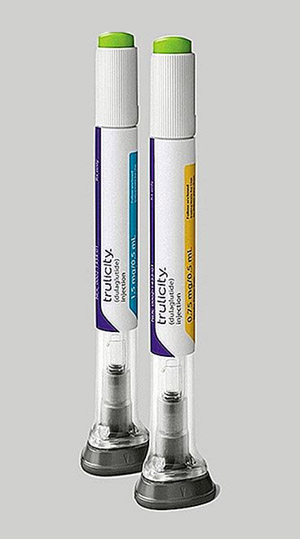Introducing dulaglutide
GLP-1 agonist dulaglutide (Trulicity) is a new injectable type 2 diabetes medicine funded by Pharmac under Special Authority.1 Self-administered once weekly as a subcutaneous injection, it comes in a single-use disposable pen. Only a 1.5mg weekly dose is available from September 1, which means dose titration is not required.1, 6
GLP-1, an incretin hormone released by the gut in response to food, is known to have the following actions:
- enhances glucose-dependent insulin secretion by pancreatic beta cells
- suppresses secretion of glucagon by pancreatic alpha cells
- signals satiety to the brain.2
By exhibiting these GLP-1 actions, dulaglutide reduces fasting blood glucose levels, postprandial blood glucose levels and appetite. Due to its appetite suppressant action, it promotes weight loss but this effect is variable. To achieve this, it must be combined with healthy eating and healthy activity.3 Other medicines in this class are being independently used as weight-loss medications, including liraglutide (Saxenda), which is registered for use in New Zealand but not funded.
Dulaglutide is not independently associated with hypoglycaemia, but it can increase the risk of this when used with medications that cause hypoglycaemia, such as insulin and sulfonylureas. Dulaglutide can also cause nausea, and occasionally vomiting: however, this side effect normally settles within the first few weeks.4 A description of common adverse effects and contraindications associated with dulaglutide can be found in the Medsafe data sheet.5
The SGLT2 inhibitor empagliflozin was also made available under Special Authority earlier this year, with the same funding criteria as dulaglutide. The choice between empagliflozin and dulaglutide as a funded second-line agent is determined by cardiovascular and renal status, and Māori or Pacific ethnicity. The Special Authority criteria promote improved access for Māori and Pacific peoples, to address inequities in diabetes prescribing and health outcomes. Guidance is available online from the New Zealand Society for the Study of Diabetes (NZSSD).6
The funding of both empagliflozin and dulaglutide by Pharmac has increased the availability of funded second-line agents for people with type 2 diabetes whose HbA1c level is greater than 53mmol/mol. Metformin remains the first-line pharmacological agent.
Pharmac will fund either empagliflozin (Jardiance) or dulaglutide (Trulicity); however, some patients may benefit from using both agents in combination.1, 7 If this is the case, consider inviting your patient to self-fund empagliflozin (the least expensive of the two agents) while receiving funded dulaglutide.
Tips and strategies for initiating injectables
The thought of self-injecting a medicine will worry most patients, so having strategies on hand for managing their move to an injectable is helpful.
There appears to be little published literature on cultural considerations relating to injectable medicines in the New Zealand context. Using a respectful approach helps. Invite patients and their whānau to share their feelings, memories and stories, acknowledge these, and offer choices and understanding around the process.
Key points
- Providing patients and whānau with knowledge will help to build acceptability of their treatment.
- Most people with type 2 diabetes will require an injectable therapy at some stage, so prepare your patient for this early.
- Do not use injectables as a threat as this will contribute to your patient feeling they have failed when one of these medicines is needed.
- The thought of self-injecting a medicine will worry most patients; have strategies on hand for managing discussions about injectables.
- Before starting a patient on injectable medicine, you need to be prepared yourself.
- Don’t be tempted to administer the first injection: it is important that patients/whānau manage this step independently.
At the start of the diabetes journey
Most people with type 2 diabetes will require an injectable therapy at some stage, so prepare your patient for this throughout the whole of their diabetes journey. How you prepare them and their whānau over the long term, and not just at the time they need an injectable therapy, will have a big impact on the whole family’s acceptance of these therapies when the time comes.
Present injectables positively:
Talk positively and pragmatically about injectable therapies. Mention them when you talk through future medication options.
“There are many tools in your toolkit or kete to help you manage your diabetes well. A range of medications are here when you need them: tablets, insulin, newer medications. They are developing and improving all the time.”
Avoid using injectables as a threat:
“If you don’t do… you may have to go on to insulin/an injectable.”
Using these treatments as a threat will contribute to your patient feeling they have failed when one of these medicines is needed, and may impair or delay their engagement with them.
Allow your patient time to express any negative feelings:
Exploring patient/whānau beliefs and perceptions of a new treatment helps improve acceptability. People often have fearful memories from a time when someone they knew was on insulin. Allow them to express their feelings about this, then validate their feelings so they feel heard. You can then ask simple questions that will help them to start re-framing those memories and moving beyond them.
For example, if your patient says: “I could never go onto insulin or inject myself”, ask: “How do you feel about needing insulin/or an injectable?” or “Tell me about any past experience you have of others being on insulin.”
Whatever they say, validate the feeling behind it: “Yes, I can see how that felt/feels scary for you.”
Allow a space in the consultation to accommodate their feelings or the consequences of those feelings – it will often be tears or sadness.
Once the time is right, you can then invite them to reframe their feelings: “Have you thought about how this could be different for you?” or “That was your mother’s experience of insulin. Your experience doesn’t have to be the same. We can help you with this.”
Offer the injectable as a choice or a trial:
Some people perceive needing insulin as “the end of the line”. Others believe that once you are on insulin, you can never come off it. However, in type 2 diabetes, a person’s need for insulin can vary over time, particularly if their weight and activity levels change.
“There may be a time when you might need to stop this medication – especially if your level of activity increases or your body weight drops.”
“You can try this for three months, then you and your whānau can decide if it is right for you”.
When your patient needs an injectable
Helping a patient start insulin is a more complex process than helping them commence dulaglutide. For more on starting a patient on insulin, work through the free online NZSSD Diabetes Knowledge Programme8 and partner with a local diabetes clinical nurse specialist to support your learning.

Starting a patient on dulaglutide
Before starting a patient on dulaglutide (Trulicity), you need to prepare yourself:
- Get a demonstration Trulicity pen from your local Eli Lilly representative. Learn how it operates through your pharmaceutical representative or an online video.
- If your patient is on insulin or a sulfonylurea, dose reduction of these agents may be needed – visit NZSSD for guidance.6
- Vildagliptin should be stopped when starting dulaglutide, as both these agents work via a similar pathway.6
- Have an instruction guide on hand to give your patient.

You will also need to prepare your patient:
- If your patient is taking insulin or a sulfonylurea, they should check their blood glucose levels regularly while taking dulaglutide. Their need for insulin and a sulfonylurea may change initially and over the long term. You and they will be able to gauge this through their blood glucose levels.
- Ask them to show you their blood glucose testing equipment and assess their skill in using it. Are their blood glucose testing strips in date? Provide them with a blood glucose record book if needed.
- Revise hypoglycaemia management with them – visit NZSSD6 for information on this.
- Provide them with a link to a Trulicity delivery video, if possible. Talk through the possibility they will experience some nausea in the first weeks of treatment.
- Supply them with the prescription for Trulicity and ask them to bring the pen to their next appointment. They will not need needles prescribed as they are pre-attached to the device.
- Advise them to store their Trulicity pen in the refrigerator and well away from the freezer compartment.
- If on vildagliptin, advise them to stop it on the day of the first Trulicity injection and provide them with guidance as to any insulin or sulfonylurea reduction needed on the day of their first injection – supply this as a written plan.
- Set up a 20 or 30-minute appointment for the first injection and invite them to bring a whānau member as support.
On the first injection day:
If possible, have the patient give their injection at the beginning of this consultation. They will be anxious before they have administered it and won’t retain details when in this state. Once they’ve done the injection, they will be relieved and more open to receiving information.
Guide the patient through their first injection:
- Use your demonstration pen to show how the device works.
- Help the patient to choose a preferred injection site. If possible, this should be in the abdomen – avoiding the umbilicus and scars – or the outer aspect of the thighs.
- Hand the patient their dulaglutide pen and be there while they give their first injection. Don’t be tempted to “help” them: it is important they manage this first step independently.
- Remind them to wait for the second click before removing the pen.
- Congratulate your patient!
Once they have completed their first injection and they are feeling more relaxed, offer the following guidance:
- Advise them to use a fresh injection site each week.
- If they are also on insulin, advise them to use widely separated injection sites for each medicine.
- Advise them to dispose of the pen in a sharps container.
- If appropriate, remind them of reductions needed to their insulin or sulfonylurea.
- If they have been taking vildagliptin, ensure they have stopped this.
- Provide written guidance on how often to inject dulaglutide (once per week, unrelated to food).
- Discuss a possible reduction in appetite and that they may want to eat smaller portions or smaller, more regular meals.
- Offer an appointment for the second injection, if needed.
- Book a follow-up for two to four weeks’ time to review.
Earn 30 minutes of CPD
This article is endorsed by the College of Nurses Aotearoa for 30 minutes professional development (CNA081).
Louise Roche Farmer, RN, BA, PGCert diabetes, is a diabetes clinical nurse specialist for THINKHauora, based in Palmerston North. Passionate about service delivery that enables people and whānau living with diabetes to recognise and develop their strengths, she takes an equity focus in her work and advocates strongly for people who have type 2 diabetes.
References
- Pharmac. (2021). New diabetes medicines: Your questions answered.
- Drucker, D. J. (2018). Mechanisms of action and therapeutic application of glucagon-like peptide-1. Cell Metabolism, 27(4), 740-56.
- Brown, E., Wilding, J. P. H., Barber, T. M., Alam, U., & Cuthbertson, D. J. (2019). Weight loss variability with SGLT2 inhibitors and GLP-1 receptor agonists in type 2 diabetes mellitus and obesity: mechanistic possibilities. Obesity Reviews, 20, 816-828.
- Eli Lilly and Company. (2017). Trulicity (dulaglutide) prescribing information (PDF, 1.09 MB). US Food and Drug Administration.
- Medsafe. (2021). Trulicity (dulaglutide) datasheet (PDF, 907 KB).
- New Zealand Society for the Study of Diabetes. (2021). Type 2 Diabetes Management Guidance.
- Buse, J. B., Wexler, D. J., Tsapas, A., Rossing, P., Mingrone, G., Mathieu, C., D’Alessio, D. A., & Davies, M. J. (2020). 2019 update to: Management of hyperglycaemia in type 2 diabetes, 2018. A consensus report by the American Diabetes Association (ADA) and the European Association for the Study of Diabetes (EASD). Diabetologia, 63, 221-28.
- New Zealand Society for the Study of Diabetes. (2021). National diabetes knowledge framework.




